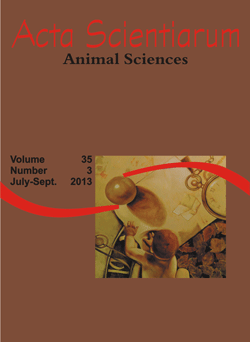<b>Production and nutrition rates of piatã grass and hybrid sorghum at different cutting ages</b> - doi: 10.4025/actascianimsci.v35i3.18016
Abstract
The influence of cutting age on yield and nutrition rates of piatã grass (Brachiaria brizantha cv. BRS Piatã) and hybrid sorghum (Sorghum spp. cv. BRS 801) under an integrated crop-livestock system was evaluated. The trial was carried out at the Embrapa Beef Cattle (20°27¢ S; 54°37¢ W) in Campo Grande, Mato Grosso do Sul State, Brazil, between April and October 2009. Experimental design consisted of randomized blocks with four replicates. Treatments were distributed across a split-plot design, which included three production systems (single piatã grass; single hybrid sorghum; mixed cultivation of sorghum and piatã grass). Half-plots consisted of three forage ages at harvest (with 70, 90 and 110 days after seeding). Variables included agronomical characteristics, productivity and nutrition value. Regardless of the evaluated systems, cutting age affected agronomical characteristics and in vitro digestibility of organic matter (IVDOM). Production was highest (4,048 kg ha-1) within the integrated system. Regardless of cutting age, monoculture sorghum had the highest crude protein level. Results showed that integrated sorghum and piatã grasses were an asset for forage productivity. Forages had higher rates in crude protein and in in vitro digestibility of organic matter on the 70th day after seeding.
Downloads
DECLARATION OF ORIGINALITY AND COPYRIGHTS
- I Declare that current article is original and has not been submitted for publication, in part or in whole, to any other national or international journal.
The copyrights belong exclusively to the authors. Published content is licensed under Creative Commons Attribution 4.0 (CC BY 4.0) guidelines, which allows sharing (copy and distribution of the material in any medium or format) and adaptation (remix, transform, and build upon the material) for any purpose, even commercially, under the terms of attribution.
Read this link for further information on how to use CC BY 4.0 properly.








































